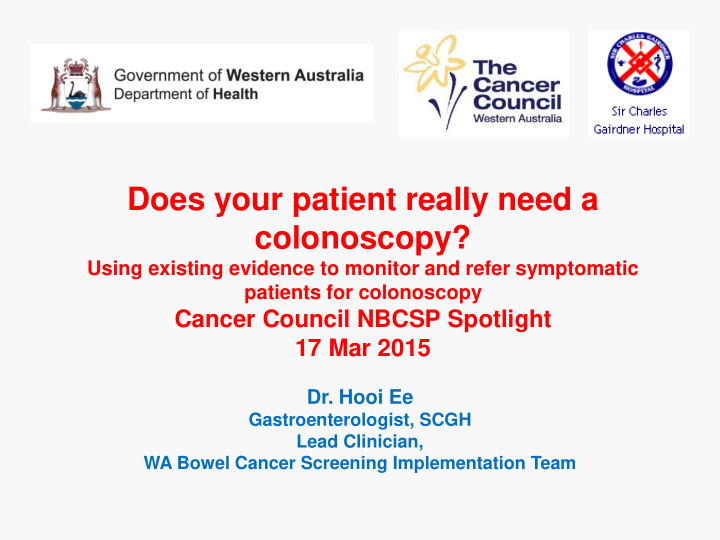



Does your patient really need a colonoscopy? Using existing evidence to monitor and refer symptomatic patients for colonoscopy Cancer Council NBCSP Spotlight 17 Mar 2015 Dr. Hooi Ee Gastroenterologist, SCGH Lead Clinician, WA Bowel Cancer Screening Implementation Team
Bowel (Colorectal) Cancer • Second commonest internal cancer after prostate • Commonest cancer affecting Men and Women – Risk = 1 in 12 by 85 yrs • Risk: M = 1:10 F = 1:15 • WA in 2013 – 1281 new cases – 431 deaths AIHW and WA Cancer Registry
Bowel cancer in Australia Incidence markedly increases after 50 yo AIHW 2015 Australian Cancer Incidence and Mortality
Adenoma → Carcinoma 5 - 20 year sequence
Bowel Cancer Diagnosis
Colonoscopy in WA • Approximately 60,000 colonoscopies p.a. • Approximately 1200 cancers p.a. • 50 colonoscopies per cancer found • Of course, colonoscopy is not just for cancer
Colonoscopy yield: WA • SCGH: 5% of colonoscopies yield Ca • Osborne Park Hospital: <2% yield cancer • NBCSP iFOBT (+): 3.4% cancer • Estimated population prevalence – 1:300-500 people >50 yo are harbouring an undiagnosed bowel cancer
What drives colonoscopy demand? • Patients, referrers, endoscopists, media • Fear – Patients fear cancer – Doctors fear lawyers – Disproportionate fear of rare anecdotes • Misunderstandings – indications, screening, follow-up guidelines – mixed messages, re-scope in 1, 3, 5 years? – cancer progression times • Technology superior to doctors’ opinions • Financial
Colonoscopy indications Most urgent • Palpable rectal mass • Palpable abdominal mass (usually RIF) • Abnormal imaging – CT scan – CT colography – PET scans – Barium enema
Colonoscopy indications Urgent • Chronic rectal bleeding > 4 weeks • Iron deficiency anaemia – Male Hb <11 – Post-menopausal Female Hb <10 – Pre-menopausal Female Hb <9 • Change in bowel habit > 4 weeks plus alarm – Palpable mass, anaemia, weight loss • FOBT (+) • After acute diverticulitis, 1 st episode
Colonoscopy indications Less urgent • Altered bowel habit without alarm symptoms • Chronic diarrhoea > 6/52 • Small polyp on imaging e.g. < 2cm
Colonoscopy indications Low risk • Constipation • Bloating • Chronic abdominal pain • Family history • Post-surgical cancer surveillance • Polyp surveillance
Low risk • Colonoscopy in last 5 years – <1% cancer – Even if presenting with symptoms – Examples • proven diverticula but repeat bleeding • bleeding but had colonoscopy <5 years ago
Inadequate referrals • What’s the family history? • Which cancers? At what age?
Inappropriate referrals • Why screen?
Stopping polyp surveillance NHMRC Guidelines: Cancer Council Australia Colonoscopy Surveillance Working Party. Clinical Practice Guidelines for Surveillance Colonoscopy – in adenoma follow- up; following curative resection of colorectal cancer; and for cancer surveillance in inflammatory bowel disease. Cancer Council Australia, Sydney (December 2011).
Patient Consultation Questionnaire 1. Blood from back passage 2. Changes in bowel habit a. Blood old/fresh a. Type of change b. Blood in/separate from stool b. Increased frequency c. Amount of blood c. Increased frequency time of day d. Frequency of blood d. Urgency e. Total length of time e. Total length of time f. In past month bleeding has f. In past month frequency has improved/worsened improved/worsened g. Normal bowel habit • Various symptoms have different scores 3. Slime +/- mixed blood 4. Incomplete bowel movement • Composite score made 5. Symptoms around back passage 6. Abdominal pain • Score determines a. Type of symptom a. Location of pain b. Total length of time b. Bloating c. Abdominal symptoms total length of time probability of cancer = Risk d. In past month symptoms have improved/worsened category • Devised for UK, still being tested in WA 7. Weight loss 8. Loss of appetite 9. Excessive tiredness 10. Medications 11. Previous illnesses 12. Family history of cancer 13. Previous colonoscopy 14. Other information
Colonoscopy hazards • Significant problem for elderly, comorbid • Fluid shifts, haemodynamic compromise • Electrolyte abnormalities • Falls risk • Anaesthetic/sedation risks • For what benefit?
Colonoscopy summary • Colorectal cancer is very common • Colonoscopy is best diagnostic test for cancer • Colonoscopy is expensive, demanding – Risk stratification improves yield • Appropriate use improves priority, accessibility, equitability
Recommend
More recommend